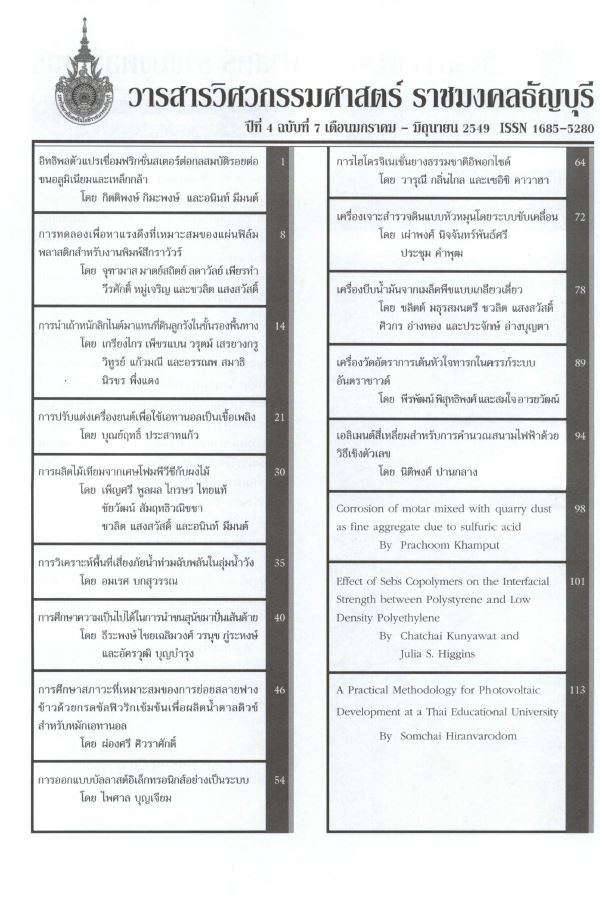A Single Screw Vegetable Oil Press Machine
Main Article Content
Abstract
The chemically extracting process is normally used to produce vegetable oils. This is due to the process is highly productive and relatively low cost. However. the vegetable oil produces in this process may contain unwanted chemicals that used during the extracting process. Alternatively. the oil pressing process is newly introduced to overcome those problems. This project aims to design and manufacture a single screw oil press machine and to study factors and conditions that suit the oil pressing process. This machine is driven by a single phase (220V) 2 horsepower electrical motor. This motor drives a single screw to press dehulled vegetable seeds such as sunflower seeds. sesame seeds. ground nuts. Pumpkin seeds and scraped coconut. This project also studied two production factors i.e. screw speeds and die sizes. Experiments were carried out by using five different screw speeds and four different die sizes. The experimental results showed that the best production conditions for: sunflower seeds and pumpkin seeds were 15 rpm of the screw speed and 8 mm of the die size: sesame seeds and ground nuts were 15 rpm of the screw speed and 10 mm of the die size: and scraped coco nut was 15 rpm of the screw speed and 8 mm of the die size. The percentages of oil produced in this process were 53. 4 1. 28. 40 and 60. the production rate were 2.60. 1.70, 1.75 and 5.52 kg/h our for sunflower seeds, sesame seeds. ground nuts, pumpkin seeds and scraped coconuts respectively. During this experiment, the temperature was kept below 60 degree Celsius to maintain the quality of the vegetable oils.
Article Details
The manuscript, information, content, picture and so forth which were published on Frontiers in engineering innovation research has been a copyright of this journal only. There is not allow anyone or any organize to duplicate all content or some document for unethical publication.
References
[2] มาลิณีย์ เลาะเมาะห์, สุพัฒน์ ทองหนูนัย และ จักรพงยขวัญเมือง. 2545. การออกแบบและสร้างเครื่องบีบอัดน้ำมันเมล็ดทานตะวันแบบใช้เกลียว. ปริญญานิพนธ์,สถาบันเทคโนโลยีราชมงคล.
[3] ชลิตต์ มธุรสมนตรี, 2647, การพัฒนาเละการศึกษาสภาวะการผลิตที่เหมาะสมในการบีบอัดน้ำมันออกจากเมล็ดสะเดา ด้วยเครื่องบีบอัดแบบเกลียวเดี่ยว,งานวิจัย, สถาบันเทคโนโลยีราชมงคล.
[4] http://www.panmai.com/GardenSong/Flower_27.htm
[5] http://classroom.psu.ac.th/users/spravit/510-211/peanut.htm
[6] http://www.thaitrip.com/herb/pumpkin.html
[7] Salunkhe, D.K., Chavan, J.K., Adsule, R.N., Kadam,S.S. 1992. World oilseeds: chemistry, technology,and utilization. Van Nostrand Reinhold. New York.
[8] มานพ ตัณตระบัณฑิต. 2540. การออกแบบชิ้นส่วนเครื่องจักรถล1, พิมพ์ครั้งที่ 1. หจก.เม็ดทรายพริ้นติ้ง,กรุงเทพฯ.
[9] คึกฤทธิ์ เนาว์สุวรรณ, งชัย จารธนสารกุล และมนตรี บุญเกลี้ยง. 2542. เครื่องทำซอสมะเขือเทศ.ปริญญานิพนธ์, สถาบันเทคโนโลยีราชมงคล.
[10] บรรเลง ศรนิล และ ประเสริฐก๊วยสมบูรณ์. 2524.ตารางโลหะ. สถาบันเทคโนโลยีพระอมเกล้าพระนครเหนือ, กรุงเทพฯ.
[11] คณาจารย์ภาควิชาพืชไร่นา. 2547. พืชเศรษฐกิจ.พิมพ์ครั้งที่ 2. สำนักพิมพ์มหาวิทยาลัยเกษตรศาสตร์,กรุงเทพมหานคร.
[12] ชาญ ถนัดงาน และ วริทร์ อึ้งภากรณ์. 237การออกแบบเครื่องจักรกล. บริษัทยูเคชั่น, กรุงเทพฯ.


